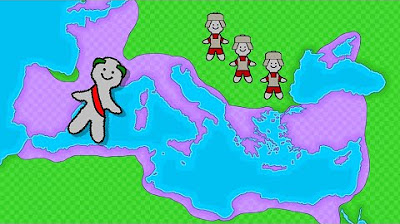STORY OF THE BYZANTINE EMPIRE AND THE RISE OF ISLAM
Summary
TLDRThis script narrates the historical impact of Islam on the Byzantine and Sasanian Empires, detailing key battles and the rise of Muslim conquests. It highlights the transformative journey of the Islamic faith, from the 7th-century conflicts to the establishment of the Umayyad Caliphate, and the subsequent Golden Age of Islamic culture. The script also introduces the One Islam TV app, promoting a modern connection to Islamic knowledge and spiritual growth.
Takeaways
- 📱 The script promotes the 'One Islam TV' app as a tool for enhancing spiritual growth and knowledge through media.
- 🏰 In the 7th century, the Byzantine Empire was a powerful entity, but it faced significant challenges from emerging forces.
- 🔱 The rise of Islam played a pivotal role in the decline of the Byzantine Empire, impacting it more than the Sasanian Empire, its long-standing rival.
- 🛡️ Emperor Heraclius led the Byzantine Empire to a major victory over the Sasanian Empire, but this was followed by internal strife and decline.
- ⚔️ The Battle of Yarmouk in 636 A.D. was a turning point, where Muslim forces defeated the Byzantine Army, leading to the end of Byzantine rule in Syria.
- 🏹 Khalid ibn al-Walid's strategic leadership was instrumental in the Muslim victories, particularly at the Battle of Yarmouk.
- 🌐 The Rashidun Caliphate, following the death of Prophet Muhammad, expanded rapidly, capturing significant territories and reshaping the region.
- 🏟️ The Byzantine Empire's losses included Jerusalem, and eventually, the entire Sasanian Empire was conquered by the Muslims.
- 📉 The Byzantine Empire never fully recovered, economically or militarily, from the losses inflicted by the Muslim conquests.
- 🏛️ The fall of Constantinople in 1453 marked the end of the Byzantine Empire, which had been in decline since the 7th century.
Q & A
What was the significance of the One Islam TV app mentioned in the script?
-The One Islam TV app is described as a transformative tool for knowledge, inspiration, and spiritual growth, aiming to improve the connection of its users to their faith and positively impact their lives.
What was the status of the Byzantine Empire in the 7th century?
-In the 7th century, the Byzantine Empire was one of the strongest in the world, but it was also during this period that it faced the emergence of a new force, Islam, which would eventually contribute to its decline.
Who was Emperor Heraclius and what was his significance in the Byzantine Empire?
-Emperor Heraclius was a significant figure in Byzantine history, known for his military prowess. He led the empire to one of its greatest victories against the Sasanian Empire, but also witnessed the rise of Islam, which impacted the empire.
What was the outcome of the war between the Byzantine Empire and the Sasanian Empire?
-The war between the Byzantine Empire and the Sasanian Empire lasted almost 20 years and resulted in a victory for the Byzantines under Emperor Heraclius, who defeated the Sasanians at the Battle of Nineveh in 627 A.D.
What was the Battle of Yarmuk?
-The Battle of Yarmuk, which took place in 636 A.D., was a decisive battle where the Byzantine Army was defeated by the Muslim forces of the Rashidun Caliphate, marking the end of Byzantine rule in Syria.
Who was Khalid ibn al-Walid and what was his role in the Muslim conquests?
-Khalid ibn al-Walid was a commander-in-chief of the Muslim armies at the time and played a crucial role in the Muslim conquests, including the Battle of Yarmuk, which was considered one of his greatest military victories.
What was the impact of the Muslim conquests on the Byzantine Empire and the Sasanian Empire?
-The Muslim conquests led to the loss of significant territories for both the Byzantine and Sasanian Empires, including the Levant, North Africa, and eventually Egypt, Libya, and Tunisia. This significantly weakened both empires and contributed to their decline.
What was the significance of the year 1453 in the history of the Byzantine Empire?
-In 1453, the Byzantine Empire came to an end with the fall of Constantinople to the Ottoman Empire, marking the conclusion of a once-glorious era.
What was the Umayyad Caliphate and its contribution to the Islamic Empire?
-The Umayyad Caliphate was the dynasty that took control of the Islamic empire after the death of the last of the Rashidun Caliphs in 661. It expanded the empire to its peak, extending its control from the Middle East to parts of Asia, India, and Europe.
What was the Abbasid Dynasty known for, and how did it contribute to Islamic culture?
-The Abbasid Dynasty, which overthrew the Umayyads in 750, is known for initiating the Islamic Golden Age. During this period, there was a flourishing of science, math, astronomy, medicine, and literature, with the construction of libraries and schools, and the thriving of arts and architecture.
How did the Muslim conquests reshape the Mediterranean and North African region?
-The Muslim conquests fundamentally reshaped the Mediterranean and North African region by creating new religious, cultural, and linguistic boundaries that persist to this day, as well as uniting nomadic people into a more unified culture through common currency, language, and standardized measurements.
Outlines

このセクションは有料ユーザー限定です。 アクセスするには、アップグレードをお願いします。
今すぐアップグレードMindmap

このセクションは有料ユーザー限定です。 アクセスするには、アップグレードをお願いします。
今すぐアップグレードKeywords

このセクションは有料ユーザー限定です。 アクセスするには、アップグレードをお願いします。
今すぐアップグレードHighlights

このセクションは有料ユーザー限定です。 アクセスするには、アップグレードをお願いします。
今すぐアップグレードTranscripts

このセクションは有料ユーザー限定です。 アクセスするには、アップグレードをお願いします。
今すぐアップグレード関連動画をさらに表示

Pre-Islamic history of the Middle East

Gli ARABI lezione completa, splendore della civiltà araba flipped classroom

PRIODESASI SEJARAH PERADABAN ISLAM | KULIAH DARING

The First Crusade - A Complete History (All Parts)

Aulas Sin Fronteras - Grado 9º - Sociales - Video 19

Histoire et évolution de l'Empire romain
5.0 / 5 (0 votes)
